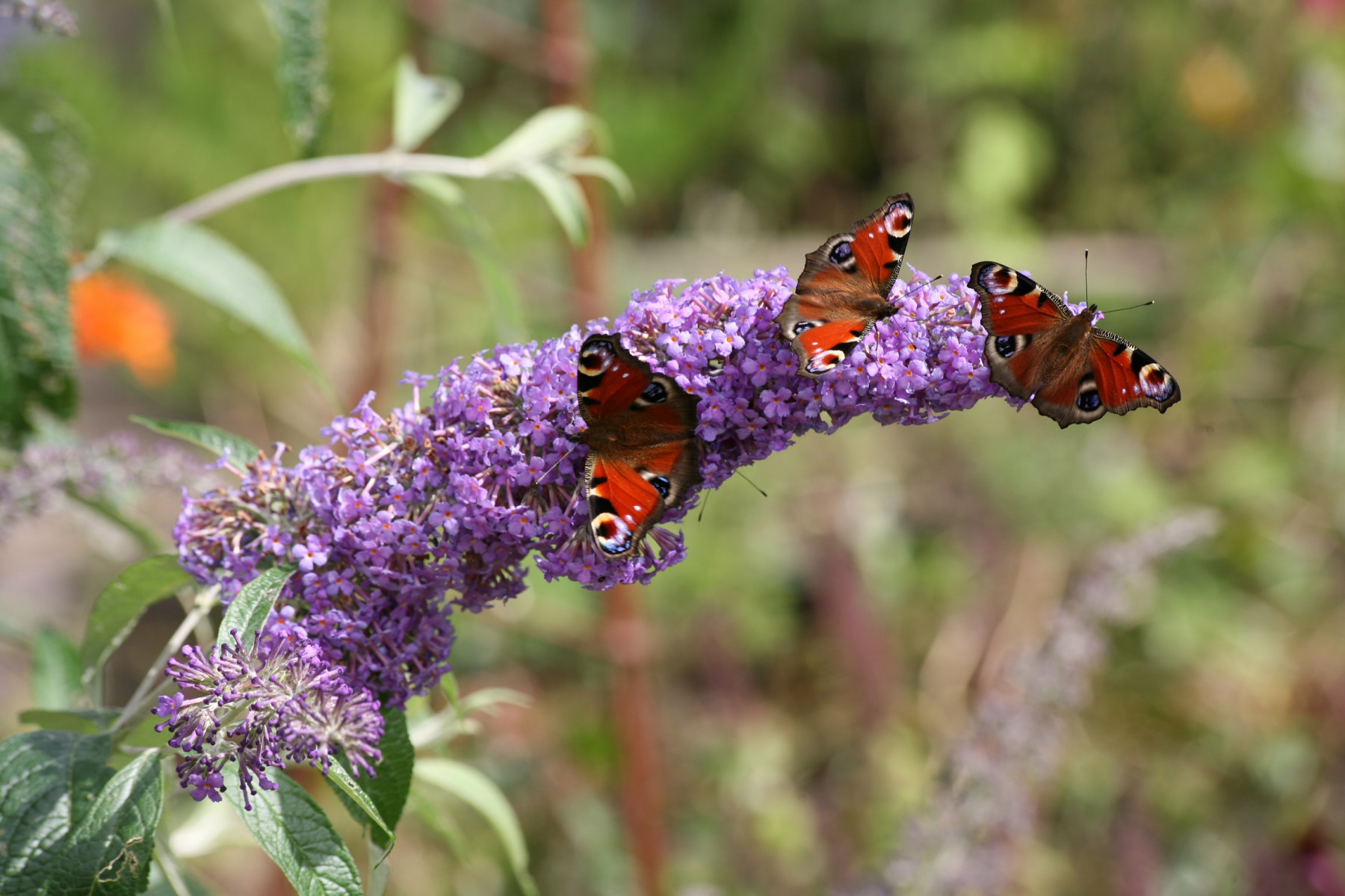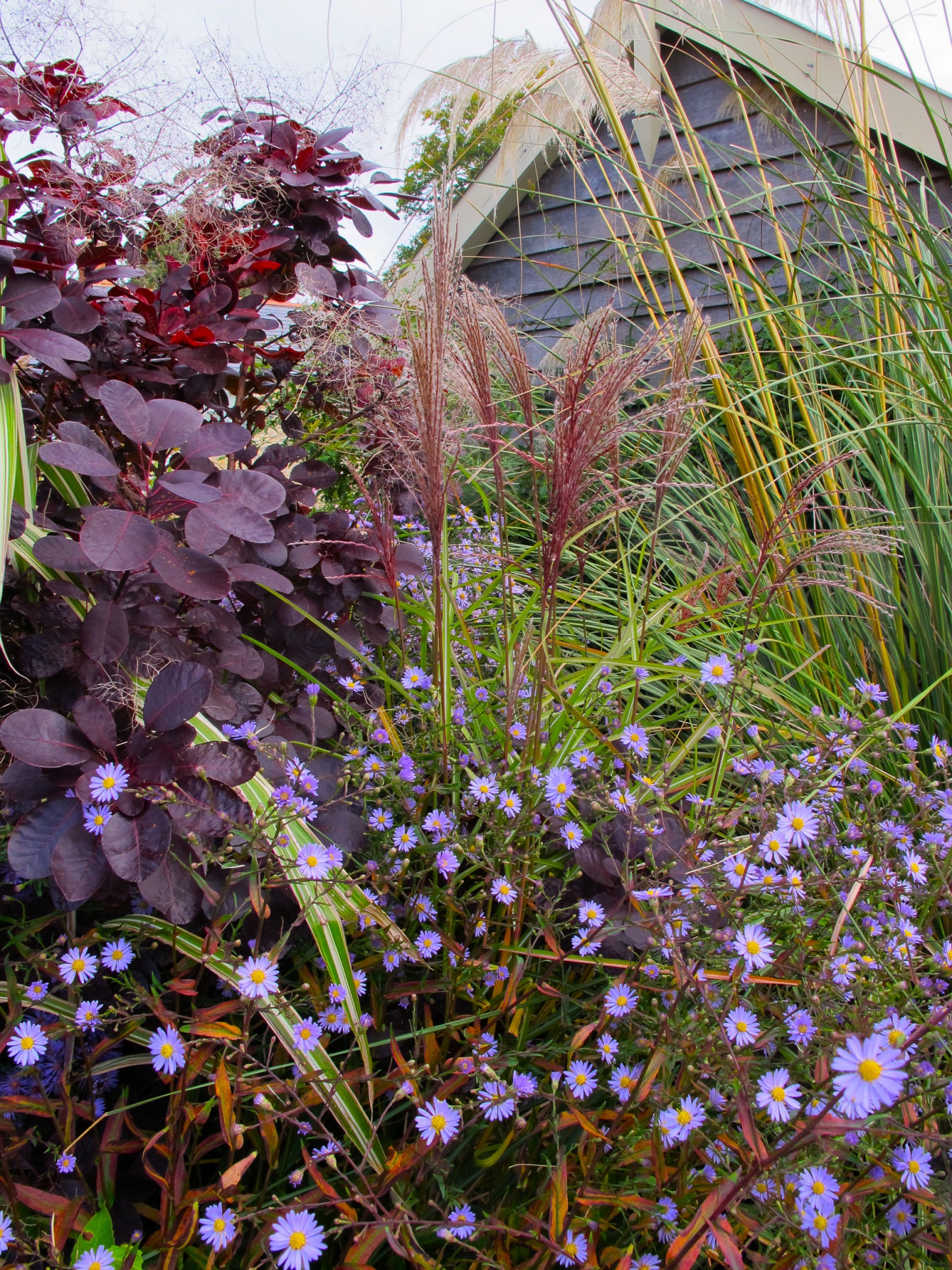
I had rather a large birthday recently, the sort you want to keep a deep, dark secret! I’ve seen a variety of gardening styles and, although I’m not quite old enough to remember Dig for Victory, I do remember the self-sufficient gardens of the 1950s, the low-maintenance shrub gardens of the 1960s, the conifers of the 1970s, the colourful gaudiness of the 1980s and the containers and colourful paint of the 1990s. They all come back to haunt me like bad dreams. Lately the tall airy, planting style has dominated, an emulation of Continental prairie planting that’s often less successful here because winters are getting wetter and warmer, whilst summers seem to be getting hotter and drier.
I have an autumn prairie-style border that sweeps round my summerhouse and there are a far few grasses in bleached golden shades amidst tall, later-flowering asters, aconitums and sanguisorbas etc. The plant that holds this area together is a purple-leafed smoke bush, Cotinus coggygria ‘Royal Purple’. The wine-red foliage lifts, what might otherwise be a dull corner. This year, following a really wet winter, my cotinus is covered in a mass of pale-pink inflorescences that give rise to its common name of smoke bush. Every time it rains, this pale haze swoons very gracefully and develops a crystal coating of raindrop jewels that gleam in sunlight. Asa summer wears on into autumn, the fluffy bits gradually disintegrate to gossamer and marry in with various grasses including Stipa gigantea and Miscanthus sinensisis ‘Ferne Osten’.
This deciduous spreading shrub, which prefers poorer soil, has several other graces. The lower stems fountain out a couple of feet above the main stem, so you can plant right up against the trunk and there are several snowdrops residing underneath. I lift the skirts of most shrubs I plant, once they’ve become established, by removing the lower branches so that I can plant right up against the stem. The Cotinus leaves appear late and that means that the wine-red lollipop foliage is still a feature in October. By then it’s developed shocking pink edges and flecks – very Barbara Cartland. Yes I know, I’m showing my age again! Those vivid pink tints really show up in November light – as the foliage falls.
Why am I wittering on about one shrub? Well, too many gardeners have written off this noble group of woody plants because they still have nightmares about those easy maintenance shrub gardens that landscapers loved to plant in the 1970s! These involved about twenty horribly gaudy monsters, including bright-yellow forsythia, thoroughly invasive cotoneaster and pink weigela. That should Not put you off. One choice summer-flowering shrub, positioned well, will lift your garden and break up the monotony of all those mound-forming perennials.
You need to think lemon-scented philadelphus, scented lilac or handsome buddleia. The trick is to choose the right one. Let’s take philadelpus for instance, or mock orange. This citrus-scented shrub, which usually bears white flowers just after the roses have finished, is so variable. The yellow-leaved P. coronarius ‘Aureus’ is invaluable in a shady position, but the foliage will scorch in full sun. It’s a manageable shrub with a gorgeous scent. I like it with the orange bracts and olive-green foliage of Euphorbia griffithii ‘Fireglow’, a wandering affair that’s magnificent in April and May.
Most of the other mock oranges are hybrids and some of them are truly awful. Take ‘Virginal’, a slur on the name if you ask me. This double-flowered upright shrub is perfect for those who born in Brobdingnag, the land of giants visited by Gulliver. They should supply a long ladder with every plant sold and it’s wind prone too. At the other extreme is ‘Manteau d’Hermine’, a double-flowered dwarf that stays a dwarf forever more, becoming twiggier year by year.

I’d go for ‘Belle Etoile’ for its damson-eyed white starry flowers. That hint of blueberry picks up the colour of so many roses. I also love it with a simple blush-centred white biennial verbascum named V. blattaria f. albiflorum. Although listed as a biennial, probably wrongly, this bridal verbascum will flower in its first year and should seed about. That’s a trait I consider an advantage, because self seeders fill gaps.
Lots of gardens have a tree lilac and these were initially raised for the cut flower trade in France. Many were bred and named by the Lemoine family who owned a nursery in Nancy in France. The father, Victor, was born in 1823 and died aged 88 in 1911. Victor was a famous plant breeder and he was the first foreigner to be awarded the prestigious RHS Victoria Medal of Honour. He raised the first double potentilla ‘Gloire de Nancy’ (1854) , the white Japanese anemone’Honorine Jobert’ and the peony ‘Sarah Bernhardt’ (1906) – cited as the most successful peony ever bred. He worked with fuchsias and begonias and also bred Hydrangea paniculata ‘Grandiflora’ circa 1862.
Victor Lemoine didn’t begin working on lilacs until he was 47 when he found himself at the heart of the Franco-Prussian War circa 1870. Unable to get away from Nancy (because the French town was occupied by Prussian troops) he looked for a diversion and centred on a double lilac already growing in his garden – Syringa vulgaris ‘Azurea Plena’. He began crossing this weedy-flowered 1840s introduction with single forms of S. vulgaris and S. oblata.
As Monsieur Lemoine got older, his chosen lilac got taller and taller and he sent his younger, nimbler and sharper-eyed second wife up the ladder armed with paintbrush, tweezers, a needle and scissors. He steadied the bottom while she collected the pollen-bearing parts from the double flowers. By 1890 he had produced a superb double-white which he thoughtfully named ‘Madame Lemoine’ and it still remains one of the finest today. In old age he worked with his equally gifted son Émile (1863 – 1943) and in time the grandson Henri (1897 – 1982) took over.

However the best garden lilacs are highly scented, with smaller racemes of flower on more compact bushes. There are three of note, all with AGMs from the RHS Woody Committee. Syringa x josiflexa ‘Bellicent’ is a pink with drooping flowers. S meyeri ‘Palibin’, a compact mauve-flowered lilac with very green foliage, could be grown in a pot. Syringa pubescens subsp. patula ‘Miss Kim’ gets to man height. These all have plenty of flowers and a lily-like scent that tree lilacs lack. They will grow in light shade too.
Philadelphus and twiggier lilacs should have a third of the old wood thinned out. They, like most summer-flowering shrubs, are not pruned hard. However buddleias need to be cut back hard, once the worst of the weather has gone, because they flower on new wood. We may not think of them as being scented, but most develop a strong honey scent when planted in full sun – to lure in butterflies and bees. The taller buddleias make great exclamation marks at the end of sunny borders and some of the older varieties still hold their own, whether it’s ‘Royal Red’ or ‘Black Knight’. Both kept their AGMs in the RHS Wisley trial that ended in 2010. New AGMs popped up and have now become readily available and they include the tall ‘Pink Delight’. I prefer a shorter red-pink named ‘Miss Ruby’ and a deep-violet named ‘Blue Horizon. They’re available from Ashwood Nurseries – www.ashwoodnurseries.com
‘Lochinch’ is the most deciduous of all, and the fine silvery leaves and smaller orange-eyed small flowers are highly popular. Longstock Park Nursery ( www.leckfordestate.co.uk ) has a Plant Heritage Collection and the best selection for sale, although you have to visit. Plant Breeder Peter Moore, the man who assembled the collection, has been breeding non-seeding hybrid buddeias that flower for longer. I am enjoying the pink flowers of B. x weyeriana ‘Pink Pagoda’ because it performs in August and September, following on from most other buddleias. This was named by Roy Lancaster. ( www.bredbypetermoore.co.uk )
There are very compact buddleias for smaller gardens too and the Thompson & Morgan’s Buzz Series is perfect at the front of a sunny border, or in a container. It comes in several colours including ‘Magenta’, ‘Indigo’ and ‘Sky-Blue”. There’s also one called ‘Hot Raspberry’.
I’ve planted a little buddleia copse close to the path up to the house. There’s a tall lilac-blue B. davidii, a short ‘Buzz Indigo’, ‘Miss Ruby’ and ‘Pink Pagoda’ and that mixture of heights and flowering times creates a spectacle from July until September. The whole idea is for butterflies to flutter up as you pass by. The record was 84 peacocks all at once. Now that is a welcome home!



